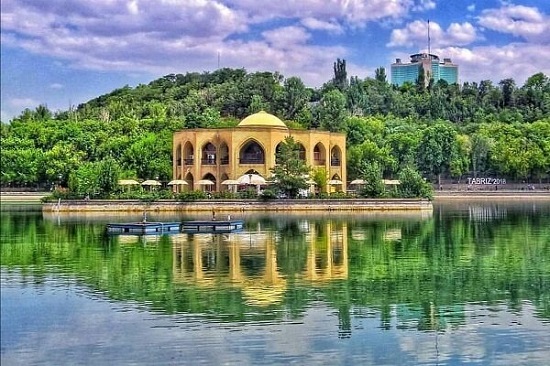It is the fourth largest city of Iran and capital of the East Azaarbayjan province, lying about 1,367 metres above sea level in the extreme northwestern part of the country. The climate is continental: hot and dry in summer and severely cold in winter. The city lies in a valley surrounded by hills on three sides. It is in an earthquake zone that is liable to frequent and severe shocks. With a population of over 1.7 million Tabriz is the largest economic hub and metropolitan area in northwest Iran. The population is bilingual, speaking both Azerbaijani (=Turkish) and Persian. Tabriz is a major heavy industries hub for automobiles, machine tools, refineries, petrochemicals, textiles and cement production industries. The city is famous for its handicrafts, including hand-woven rugs and jewellery. Local confectionery, chocolate, dried nuts and traditional Tabrizi food are recognised throughout Iran as some of the best. Some of the most esteemed cultural institutions in Northwest Iran are located in Tabriz, which is also a center for intellectual activity.

You may visit a historical museum in a gorgeous home close to the Maqbaratoshoara. The creation of the Qajar Museum, which is housed in a stunning old mansion that belonged to Amir Nizam Gross, Hasan Ali Khan, is regarded as one of the best Tabriz heritage monuments, dating back to the middle of the Qajar era. The 1500 square meter palace of Amir Nizam is constructed on two levels in an introverted architectural style. This museum features a number of display rooms, including ones for Qajar-era money and coins, dishes, colorful tiles, guns and weaponry, musical instruments, and more.
According to the writing engraved on the facade of the mosque, the Blue Mosque’s history began in the Persian Empire in the year 1465. The mosque is one of the most well-known Tabriz historical places to visit. Upon admiring the grand entryway, tourists will note the broken mosaic with missing turquoise tile pieces, which depicts a nation that has endured several earthquakes throughout history, including the tragic quake in 1779 that ruined the Blue Mosque’s splendor.
More of the stunning turquoise mosaic may be found on the walls of the mosque. If you look closely, you may see the intricate

By continuing your trip to the southwest of the museum in order to reach the citadel, you may visit the Gajil Gateway on your way, which is something you should definitely not miss, as you travel south from the area where the Constitution Museum is situated. The Tabriz Alisha Citadel has had several renovations and additions since it was first built at the beginning of the 14th century. This remarkable complex is one of the greatest Tabriz historical landmarks.
This 700-year-old structure, which was constructed during the time of one of the Gorkan kings, Tajuddin Alishah Jilani, comprises a mosque, a school, and a monastery. During the time of its construction, the Alisha Citadel and its surrounding complex were the most notable structures in Tabriz. This structure is the only one in Tabriz that has been observed from a distance, claim historians. It is important to note that Ali Baba Tabriz Kebab, which is well-known for its “Tawa Kebab” and which is highly advised to try, is situated behind Ark, at the intersection of Imam Khomeini and Street South Shariati Street (South Shahnaz).
The best place to see one of Tabriz historical landmarks is this market, which is a must-see. So, it is best to start your journey by going to this amazing location in the city’s core. Iran’s bazaars grew in towns along the routes of the old caravans, creating networks that connected areas of business and culture. The majority of Iranian bazaars are constructed as ensembles over time by erecting and linking public and commercial structures like dokkans, covered caravanserais, and caravanserais outside the bazaar (shops).